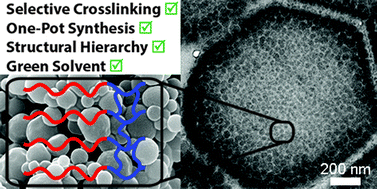In situ crosslinking of nanostructured block copolymer microparticles in supercritical carbon dioxide†
Abstract
We report a novel and facile approach to “fix” the internal nanostructure of block copolymer (BCP) microparticles via in situ crosslinking copolymerisation in dispersion in supercritical CO2 (scCO2). By delaying the addition of the crosslinker and a portion of the second monomer, polymerisation induced microphase separation (PIMS) within the microparticles is well preserved, while the growing chains of the precursor poly(methyl methacrylate)-block-poly(4-vinyl pyridine) (PMMA-b-P4VP) or poly(methyl methacrylate)-block-poly(benzyl methacrylate) (PMMA-b-PBzMA) microparticles are crosslinked. The unique structure of the as-synthesised crosslinked microparticles was fully characterised using transmission electron microscopy (TEM), scanning electron microscopy (SEM) and atomic force microscopy (AFM). Moreover, the swelling and solubility behaviour of the crosslinked PMMA-b-P4VP microparticles was investigated. Notably, the porosity generated by swelling in ethanol can be well controlled by the quantity of crosslinker incorporated. Macropores > 100 nm–∼20 nm, sub-10 nm mesopores, and non-porous microparticles were all achieved by varying the crosslinker incorporation from 0, 0.5, 1, to 4 wt%, respectively. In situ AFM nano-mapping of the crosslinked P4VP domains in 80% humidity revealed that microparticles with a high degree of crosslinking (8 wt% divinylbenzene) are highly resistant to swelling in humidity, by contrast to their non-crosslinked counterparts. This versatile approach further expands the available repertoire for fabricating porous BCP microparticles with tunable physico-chemical properties, morphologies and pore sizes, greatly broadening their application potential to more diverse fields.



 Please wait while we load your content...
Please wait while we load your content...